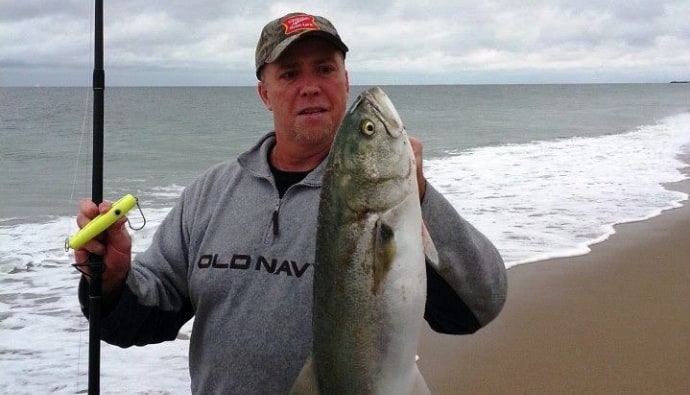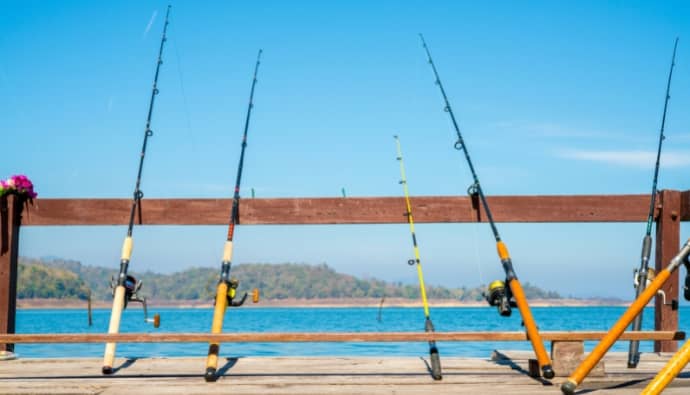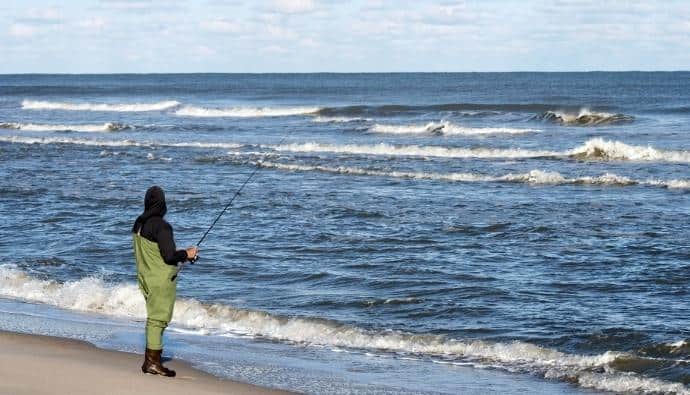What could be better than a day at the beach? Of course, doing a little surf fishing!
We’ve put together some helpful surf fishing tips in this guide to get you started.

Overview
Also known as shore or rock fishing (depending on where you are casting from), surf fishing can be a great way to spend time with the whole family or an exciting day catching fish.
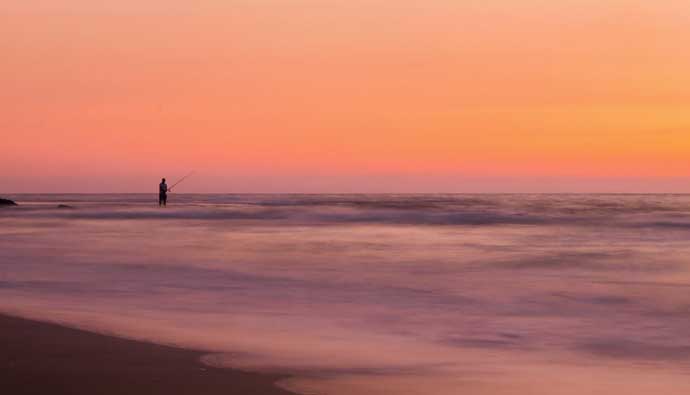
Sunset and sunrise are two of the best times to fish the surf. The colors of the sky can be breathtaking, with pink, orange, or even (in perfect conditions) a green flash!
You don’t have to be an expert angler to have a successful surf fishing experience. With the tips from this article, you will have the knowledge you need to go out and catch one!
Let’s dive in!
What is Surf Fishing?
Surf fishing is the sport of catching fish standing on the shoreline, casting from the rocks and cliffs, or wading in the surf.
The terms surf casting or beach casting refer more specifically to surf fishing from the beach by casting into the surf at or near the shoreline, regardless of the composition of the shorelien in question, whether rocks, sand, cliffs, etc.
For many surfcasting applications, rods are much longer than standard fishing rods. They can measure as long as 18 feet or more for some surf casting applications, though typically, they are much shorter, usually 9-13 feet or so.
Fixed-Line vs. Distance Casting
The primary reason for the extra length is to give leverage when casting. The fixed-line community is fond of 10-meter rods, or even longer, for targeting certain panfish, especially from cliffs or rocky areas. This is because the main objective when surf fishing is to cast as far as possible regardless of gear, but there are exceptions to this. This often gives you a better chance of landing larger fish, no matter the fishing method.
Surf fishing differs quite a bit from pier fishing. The surf fishing rods are much longer. As a rule, the casting distance is much farther, typically, and the targets are usually a bit different. Accuracy can take on a whole different level of importance as well.
In many cases with pier fishing, you are simply dropping your bait into the water or casting shorter distances, as a general rule. There are exceptions to this.
Surf Fishing Rigs
Surfcasting rigs also differ from standard saltwater fishing rigs. They can have multiple lines and are more weighted as a general rule, though there are many rigging possibilities in the list for targeting fish on the regular. In some parts of the world, the paternoster rig is extremely popular for presenting multiple baits across the water column.
A fishfinder-style rig (with or without a styrofoam float to combat potential crab problems) can be handy for exploring new areas (as the name suggests).
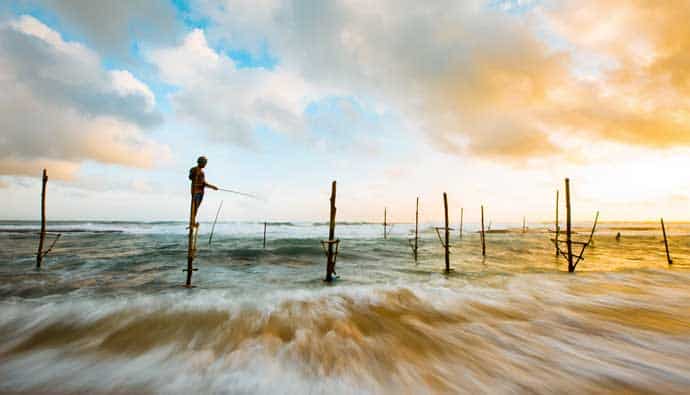
At some beaches, anglers report better fishing as the day wears on. Another popular time to fish is at dusk when the water begins to cool, and fish come off the bottom to hunt for food, and the panfish we often rely on for food feed before they hide for the night.
Tidal and Other Water Flows
Tide can also be a factor at any time of day. Watch the ebb and flow of currents. Fish are often in the trough between the beach, sandbars, or a reef, but they flow through gaps, especially when the tide or current is running hard.
You can see the outward flow on the surface. It is productive to position yourself to fish the outflow of any area where you see a rip current or outflow area exists. This is important if the mud or colored water line extends out into the ocean in front of where you are. Fish often feed heavily in such areas.
Another factor in surf fishing is, in many cases, you are fishing against more swift-moving water. A steady, progressively faster cast with a release at 1 o’clock will give you the most distance on typical gear. Watch your back-cast, but this style will help you dial in where the fish are. Distance casting might be completely necessary here, or you may be casting into inches of water, depending on the conditions.
Many surf fish are not shy about entering very shallow water.
This can take some getting used to.
Hazards to Watch for When Surf Fishing
Undercurrents
Because of the fact you will be wading out from the shore, there are undercurrents that can be quite strong and even be a drowning hazard for people who don’t understand how the surf really works, so err on the side of caution when you can.
These currents can be strong even for the most experienced angler or swimmer. It is crucial to be aware of the currents in the area you are fishing, even if you are well aware of the dangers.
The last thing you want is to be swept out to sea or lose your gear in the surf!
Debris & Dangerous Ocean Animals
Rocks, coral, or shells below the surf, are just a few examples of debris that can be hidden underwater: some manmade hazards include lost fishing gear like lobster traps, or longline gear, so we all have to be on the lookout.
Jellyfish and other biting/stinging ocean life can be a huge problem for a barefoot angler. Especially the potential stingray menace. Here in southern California, the stingrays are super dangerous, so shuffle your feed before you step!
Sandals or Crocs are a good idea before entering the water. Some fishermen even elect to wear hip waders, but the Coach likes to use knee boots while fishing the surf.
Even if the shoreline looks clean, there may be items washed up just out of sight from miles away. Look for dark water and cues from the birds about where to start casting for fish.
As much as you may like to feel the sand between your toes, it may not be a good idea. You may get more than you bargained for, especially with the rays, in some areas.
License and Permits
Permits and license requirements can differ depending on the state you are fishing in and the beach you are on.
A good example is the Florida Atlantic Coast. You need a free resident shoreline license, which can be obtained online from the Florida Fish and Wildlife Commission.
Nonresidents must purchase a 3-day, 7 days, or annual non-resident saltwater fishing license. This is when saltwater fishing from the shore or a pier, bridge, or jetty is attached to the shore unless fishing on a pier with a pier license.
The shoreline license does not apply when fishing offshore from a boat. Free means that you pay nothing for the license, but you may have to pay a service fee.
Note: No license is needed if you are under 16 or over 65 with an ID showing proof of age.
It is a good idea to check with the Fish and Wildlife Commission in the area you will be fishing to see what they require.
Surf Fishing Gear
Check out our in-depth surf fishing gear guide here.
Surf Fishing Rod Holders
Rod holders keep your rod and reel out of the sand. You can buy them, but it’s easy to make them yourself out of a three-foot length of PVC pipe (often called sand spikes, with a 45-degree angle cut at the end that goes into the sand).
Use a hacksaw to cut a point at one end for driving into the sand. Pack a rubber mallet and pound it into the sand if necessary.
For an easy trick to set the PVC pipe without a mallet, try this:
The Beach Cart
A PVC-framed cart for carrying gear can be a good idea, depending on the amount of gear you are carrying.
You can purchase these handmade carts at many beach-area baits and tackle shops for $150-$200, or you can build one yourself to meet your specific needs.
The key to building a successful cart is the beach wheel, which needs to be wide and roll freely.
Surf Fishing Tools
Bait knife, pliers, gloves, and nail clippers. You need pliers to remove hooks from your fish without hurting the fish, and nail clippers are indispensable.
Gloves are useful for holding your catch and protecting your hands from sharp teeth and fins.
Special casting gloves without fingertips can be purchased. They can be mesh fishing gloves, but throwaway vinyl gloves do the least damage to your fish.
The nets can be a big help as you reel your catch to shore, fish bounce in the surf, and get thrown off your hook, with some additional support provided by a hoop net.
Surf Fishing Tackle
Surf Fishing Line
Monofilament line is the choice of most surf anglers, but some old-school fishers and long-distance lure throwers often use braided lines.
Today’s braided lines are far superior to those cotton and Dacron lines of old. They are thinner and stronger. Approximately 150 yards of 30-lb braided line with a monofilament backing of another 200 yards is recommended.
This allows room for the fish to run and wear itself out. Another choice is monofilament, 10-lb. to 25-lb. test.
Surf Fishing Sinkers
Pyramid sinkers are used in sandy areas because their shape digs into the sand to hold your bait near the bottom with minimal movement.
They come in various sizes, and it is a good idea to bring a selection for varying surf conditions.
Some ‘sputnik’ style weights have wire anchors, although they can be troublesome. Egg sinkers and bucktail jigs work as well for fish in some areas.
A little bounce on the bottom stirs up the sand, attracting fish. In a calm surf, let your bait swim on a line unencumbered by as minimal weight as you can (or none at all) whenever possible.
Basic Rigs
The basic rig for most saltwater fishing is called the fishfinder or sliding rig. Slip the tag end of your line through the eye of your sinker, then attach a swivel big enough to stop the slide.
On the other end of the swivel, a leader with your hook, always match the hook to bait size and line size to target. Add bait and cast as far as you can.

Special Rigs
The pompano rig has two or three sub-leaders, spaced and tied off on the main leader, with small circle hooks.
Clip a pyramid sinker to a swivel at the bottom of the rig. Simple to use and effective in the surf, especially for pompano.
Fishfinder rigs, high-low rigs, and fireball rigs also work very well. They take some practice making.
Lures, Jigs, and Surf Fishing Baits
Other than jigs, lures are not always effective in the surf, except when fish are running. You might try an artificial lure, but live bait is always best, and bait shops usually have plenty of live bait.
At other times, try a live shrimp on a jig, then bounce it on the bottom a few times in the surf.
The jig of choice for surf fishing is the feathered bucktail jig tipped with a small piece of shrimp.
Sand fleas
They are a small type of mole crab. Some people call them Sand Crabs. Premium bait for a pompano, a delicious white-flesh fish, and prime game in Florida’s Atlantic coastal waters. They are also fantastic bait for surf perch, whiting, and even calico bass when used fresh and alive.
Watch for tiny disruptions in the outward flow as the surf rolls back, showing as a V. Those are antennae. Scoop the sand around the crab and dig them out.
Shrimp
Live is best, but frozen works in a pinch, just not as well. With live shrimp, you need a bucket and an aerator to keep them alive for a day of fishing.
The aerators run on batteries and attach to your bucket. Add seawater, and drop the tube with an aerator head into the water to continually add oxygen. Without an aerator, the shrimp will not live long.
Catch and Release or Catch and Keep?
Decide ahead of time whether you plan to release your catch. When you land the fish, please pick it up carefully but firmly and remove the hook.
Wet your hands first so that you don’t remove the slime that protects the fish. Once the hook is removed, carry it into the surf and gently release it in the water.
Release Fish with Care
It is not a good idea to “throw it back” too hard. Throwing the fish into the ocean can injure it, resulting in it dying after being slapped against the sand, rocks, or even seaweed. Some fish are tougher and survive, but it’s best to err on the side of caution.
Watch out for barbs, teeth, and sharp fins. If the fish does not move, give it a nudge so the water will flow through its gills.
Hold it under the water, supporting its belly with your hand. Nudge it back and forth until it gets its strength back. If the fish seems to be struggling and is legal to take (even for bait or food for your vegetables), take it home. Better yet, cook it up if you can, or give it to someone on the beach who will not let it go to waste.
Surf Fishing Tips Frequently Asked Questions
Q: What is the best time to surf fish?
A: Tide can also be a factor at any time. Watch the ebb and flow of currents. Fish are often trapped in the trough between the beach, sandbars, or a reef, but they flow through gaps when the tide allows.
Q: What is surf fishing?
A: Surf fishing is the sport of catching fish standing on the shoreline, from the rocks, or wading in the surf. The terms surfcasting or beach casting refer more specifically to surf fishing from the beach by casting into the surf at or near the shoreline.
Q: What is the best bait for surf fishing?
A: Live baits such as sand fleas, shrimp, and cut baits. Market shrimp chunks and squid strips are a great place to start.
Q: What is the best surf fishing rod and reel?
A: Penn Spinfisher V 6500 Surf Rod and Reel Combo have had some of the best reviews. More content to come on this for the budget-minded.
Q: How to rig for surf fishing?
A: Step 1
Choose a surf rod that will be able to cast over the rolling surf. Surf rods are like any other rod but are much longer. They usually come in sizes from 10 to 14 feet. Make sure to choose a rod that you will be able to handle and that is not too big for you. As long as you are able to cast over the breaking surf and get into the calmer waters, you will be able to catch fish.
Step 2
Select a medium-weight line to use on your pole. Usually, a 10- to 20-lb. test will do the trick. These are medium-weight, all-purpose line strengths that will hold up in a variety of situations, including fishing in the surf.
Step 3
Use a pyramid sinker at the end of your line on smooth bottoms. In rockier areas, use steel on a breakaway or a torpedo-style weight that will slip through rocks and kelp easier. The rougher the water conditions, the heavier the sinker you will need. If conditions are basically normal, a 3-oz. triangle sinker should work fine. If you use a sinker that’s too lightweight, it will not hold ground and will be pulled back into shore. Too heavy, and your bait will sit totally static, or you may miss light bites.
Step 4
Tie two to three hooks spaced about a foot apart, approximately 8 inches to two feet above the sinker. The more hooks you tie on your line, the more bait you will be able to rig the line with. This will give you more chances of catching a fish. There does come the point where fishing too many hooks is a nuisance (or illegal in some areas). Imagine trying to cast a rig with twenty-five or thirty hooks…no thanks!
Step 5
Use bait that will attract fish in the surf. Shrimp, clams, sand fleas, live fish, cut-up fish, and squid are a few of the selections you have. You should be able to find any of these bait at a local bait store or ethnic market (these local markets are great for fresh bait). If unsure of what will work best, ask the locals what they use to catch fish in the surf.
Insider Advice
Once you master the art of surfcasting, you are well on your way to being a seasoned surf fisherman.
Surf fishing can yield some good fishing. It is not unusual to catch sharks, large flounders, and not to mention redfish, striped bass, calico bass, rockfish, and even salmon and lingcod in some areas.
The type and size of the fish you catch will differ depending on where you are fishing. But one thing is for certain, they are always there, depending on species, tide, and ocean water, but almost always, all ocean water has a good amount of life in it if you know what you’re looking for.
Larger fish routinely patrol shorelines in search of an easy meal. These easy meals are usually schools of baitfish, crabs, squid, or shrimp that congregate close to the shore.
This is one of the main reasons live bait is so productive.




 Facebook
Facebook YouTube
YouTube
